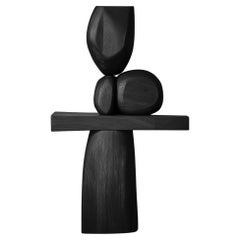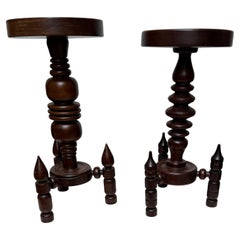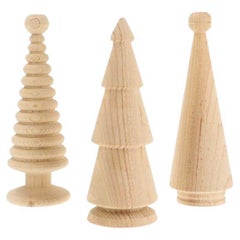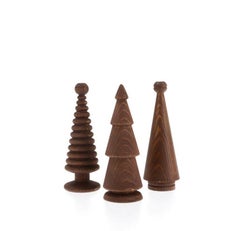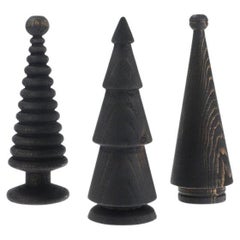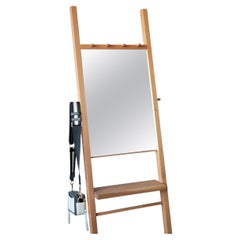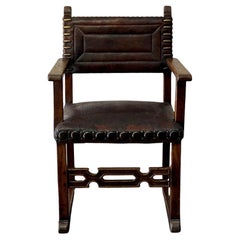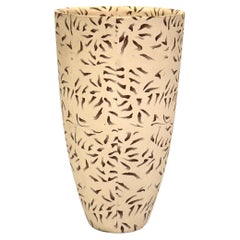Design Craft
to
2,714
13,566
13,412
16,432
14,047
837
7,660
6,934
1,629
1,529
1,147
286
236
170
145
103
102
101
99
92
83
83
82
30
267
1,342
14,812
14,887
1,969
8,282
3,079
256
147
408
551
335
1,730
2,981
1,595
534
290
13,252
10,782
7,320
4,851
4,273
17,751
6,285
5,202
4,951
4,536
31,293
21,951
25,559
1,059
937
650
484
426
Sort By
Lull No132 Wooden Sculpture for Interior Design – Crafted by Joel Escalona
By Joel Escalona
Located in Ciudad de México, CDMX
Lull No132 Wooden Sculpture for Interior Design – Crafted by Joel Escalona
———
Balance and tension
Category
2010s Mexican Modern Abstract Sculptures
Materials
Hardwood
$16,042 / item
H 70.87 in W 13.78 in D 13.78 in
Rare & Timless Design Crafted Solid Wood End or Side Tables Attr Charles Dudouyt
By Charles Dudouyt
Located in Lisse, NL
unique style that blended traditional French craftsmanship with modernist forms, Duduoyt's designs are
Category
Mid-20th Century French Brutalist End Tables
Materials
Wood
$6,352
H 22.7 in Dm 10.3 in
Wooden Christmas Tree Set – Cedar, Medium Size
By Ananas Design + Crafts
Located in Orlando, FL
refined design.
Crafted entirely from solid cedar wood, each tree features unique natural patterns and
Category
2010s Turkish Modern Desk Sets
Materials
Wood, Cedar
Wooden Christmas Tree Set – Cedar, Medium Size
By Ananas Design + Crafts
Located in Orlando, FL
refined design.
Crafted entirely from solid cedar wood, each tree features unique natural patterns and
Category
2010s Turkish Modern Desk Sets
Materials
Wood, Cedar
Wooden Christmas Tree Set – Cedar, Medium Size
By Ananas Design + Crafts
Located in Orlando, FL
refined design.
Crafted entirely from solid cedar wood, each tree features unique natural patterns and
Category
2010s Turkish Modern Desk Sets
Materials
Wood, Cedar
Wooden Framed Organizer Mirror
By Ananas Design + Crafts
Located in Orlando, FL
timeless design. Crafted with the natural texture of oak and skilled handcraftsmanship, this modern minimal
Category
2010s Turkish Modern Wall Mirrors
Materials
Mirror, Wood, Oak
Arts & Crafts Oak Chair
Located in Los Angeles, CA
This 19th-century English armchair combines historical charm with timeless design. Crafted from oak
Category
Antique 1880s English Arts and Crafts Armchairs
Materials
Oak
An American Studio Craft Ceramic Vase with Included Design
Located in Philadelphia, PA
An American Studio Craft Ceramic Vase with Included Design. Crafted from a hand designed included
Category
Late 20th Century American Vases
Materials
Ceramic
Wooden Candle Holder, Large– SOFRA
By Ananas Design + Crafts
Located in Orlando, FL
its large-scale design. Crafted entirely by hand from a single piece of solid cedar wood, this modern
Category
2010s Turkish Scandinavian Modern Candlesticks
Materials
Wood, Cedar
Room Sized Contemporary Tibetan Wool & Silk Rug Designed IIn Dark Green Color
Located in Norwalk, CT
This modern Tibetan weave rug boasts a striking striped design. Crafted from high-quality Tibetan
Category
2010s Nepalese Modern Central Asian Rugs
Materials
Wool, Silk
$9,800
W 110 in L 152 in
American Studio Craft Brutalist Round Wood Wall Hanging Mirror Sculpture 1980s
Located in Troy, MI
Artist made one of a kind mirror sculpture by Bruce Quinby 1986
Creative design crafted of convex
Category
Late 20th Century American Post-Modern Wall-mounted Sculptures
Materials
Mirror, Wood
$1,650
H 6 in Dm 18.5 in
Holger Strøm Designed Mid-Century Ribbon-Style Pendant
Located in Brooklyn, NY
, and features a dynamic ribbon-style design crafted from molded plastic. Its flowing, layered form
Category
20th Century Unknown Mid-Century Modern Chandeliers and Pendants
Materials
Plastic
Pair of Antique French Andirons
Located in West Palm Beach, FL
Pair of Antique French Brass Andirons. A beautiful flowing design crafted in solid brass.
Category
Antique 19th Century French Rococo Fireplace Tools and Chimney Pots
Materials
Brass
Mid Century Christofle Vase Lino Sabattini design 1960s
Located in Los Angeles, CA
innovative mid-century design. Crafted by the renowned Italian designer, the vase showcases a perfect harmony
Category
Vintage 1980s Italian Mid-Century Modern Vases
Materials
Silver
Block, Handcrafted Rectangular Solid Oak Chopping Board
By Ananas Design + Crafts
Located in Orlando, FL
.
However, what truly sets apart each and every Ananas Design Crafts product is the undeniable uniqueness
Category
2010s Turkish Scandinavian Modern Serving Pieces
Materials
Wood, Oak
Contemporary, Biophilic, cloud coffee table
Located in Los Angeles, CA
Organic Biophilic influenced design. Crafted in Los Angeles California. Solid Acacia wood.
Please
Category
2010s American Modern Coffee and Cocktail Tables
Materials
Hardwood
Teak Lounge Chairs from Spain
Located in Pasadena, TX
Teak Lounge Chairs from Spain
Unique mid century style design crafted in Spain.
Teak and chrome
Category
Late 20th Century Spanish Mid-Century Modern Side Chairs
Materials
Teak
Oreadi Nemesi Green Guatemala Marble Candlestick by Rotella
By Fuda Marmi by Atelier Design Lab
Located in Milan, IT
The Oreadi Nemesi candlestick features a sculptural design crafted from a single block of Guatemala
Category
2010s Italian Candlesticks
Materials
Marble
$781 / item
H 15.75 in W 3.94 in D 3.94 in
Luxury Solid Wood Pitta Bar Cart with Timeless Brazilian Design
By Amilcar Oliveira
Located in São Paulo, SP
The Pitta Bar Cart is a piece that combines functionality with timeless design. Crafted from solid
Category
21st Century and Contemporary Brazilian Modern Carts and Bar Carts
Materials
Hardwood
$2,680 / item
H 29.93 in W 25.2 in D 53.55 in
French Art Deco Walnut Starburst Marquetry Moderne Side Table Circa 1930
Located in Los Angeles, CA
design crafted from highly figured walnut veneer. In the style of Émile-Jacques Ruhlmann. Very good
Category
Vintage 1930s French Art Deco Side Tables
Materials
Walnut
$15,850
H 22.5 in W 27.5 in D 27.5 in
Two Beveled Mirror Side Cabinets
Located in Palm Springs, CA
silver leaf wood trim. By William Lyons Design Craft of NYC, 1975
Category
20th Century American Modern Cabinets
Materials
Mirror, Wood
Pair of Beveled Mirror Side Cabinets
Located in Palm Springs, CA
silver leaf wood trim. By William Lyons Design Craft of NYC, 1975
Category
20th Century American Modern Cabinets
Materials
Mirror, Wood
20th Century American Craft Associates Walnut Sofa Table by Adrian Pearsall
By Craft Associates, Adrian Pearsall
Located in West Palm Beach, FL
manufacture his furniture designs. His designs are considered to be part of the Atomic Age design.
Craft
Category
Mid-20th Century American Mid-Century Modern Coffee and Cocktail Tables
Materials
Glass, Walnut
$4,900
H 15.75 in Dm 36 in
Hand-Knotted Jaipur Wool Rug in Classic Gray, Minimalist Solid Design
By JAIPUR RUGS
Located in Milano, IT
minimalist, solid design. Crafted by skilled artisans, the rug's high-quality wool provides a soft, luxurious
Category
21st Century and Contemporary Indian Modern Rugs
Materials
Cotton
Black Wood Mirror, Organic Design and Matte Finish, 39-Inch - Pantê Series
By Uultis Design
Located in Miami, FL
combines natural beauty and artistry with practical design. Crafted with precision, the mirror is framed by
Category
2010s Brazilian Modern Wall Mirrors
Materials
Mirror, Wood
$1,788 / item
H 39 in W 39 in D 2 in
Black Wood Mirror, Organic Design and Matte Finish, 47-Inch - Pantê Series
By Uultis Design
Located in Miami, FL
combines natural beauty and artistry with practical design. Crafted with precision, the mirror is framed by
Category
2010s Brazilian Modern Wall Mirrors
Materials
Mirror, Wood
$1,305 / item
H 47 in W 23 in D 1 in
Antique Persian Bakhtiari Handmade Rust Rosette Wool Rug
Located in Norwalk, CT
rosette design, crafted with the utmost care and detail.
This rug measures 9'10" x 12'7".
Category
Early 20th Century Persian Bakshaish Persian Rugs
Materials
Wool
Italian Design : Fully Restored 1950s Desk Chair with Armrests
Located in Rome, IT
Introducing a rare find from the 1950s, this desk chair embodies iconic Italian design. Crafted
Category
Vintage 1950s Italian Mid-Century Modern Office Chairs and Desk Chairs
Materials
Iron
$1,550
H 32.68 in W 22.05 in D 20.87 in
Italian Design Icon: Rare 1950s Desk Chair with Armrests
Located in Rome, IT
Introducing a rare find from the 1950s, this desk chair embodies iconic Italian design. Crafted
Category
Vintage 1950s Italian Mid-Century Modern Chairs
Materials
Iron
French Faux Bois Limestone Trough
Located in Dallas, TX
design crafted from durable limestone. Perfect for adding a touch of historic elegance to any outdoor
Category
Antique Early 1900s Stone Sinks
Materials
Limestone
9x12 Wool Rug – Red Checked Design
Located in Los Angeles, CA
striking red checked design. Crafted in Nepal, this all-wool rug combines durability and softness, making
Category
2010s Nepalese Russian and Scandinavian Rugs
Materials
Wool
Contemporary Tibetan Wool & Silk Square Rug In Brown Color
Located in Norwalk, CT
This modern Tibetan weave rug boasts a striking striped design. Crafted from high-quality Tibetan
Category
2010s Nepalese Modern Central Asian Rugs
Materials
Wool, Silk
Hand-Knotted Jaipur Wool Rug in Pure White, Minimalist Solid Design
By JAIPUR RUGS
Located in Milano, IT
sleek, minimalist design. Crafted by skilled artisans, the high-quality wool provides a soft, plush feel
Category
21st Century and Contemporary Indian Modern Rugs
Materials
Wool
$1,343 Sale Price
34% Off
W 64.97 in L 106.3 in
Charlotte Perriand Tabouret Meribel Stool in Oak by Cassina
By Cassina
Located in Sag Harbor, NY
The Charlotte Perriand Tabouret Meribel Stool is an iconic design crafted from oak. It features a
Category
2010s Italian Stools
Materials
Oak
Greece White Marble Sink
Located in Dallas, TX
This Greece White Marble Sink is inspired by the grandeur of 18th century design, crafted with
Category
Antique 18th Century Stone Sinks
Materials
Marble
Pair Modern Lucite Benches by Pegaso Gallery Design, Fluorescent Green Details.
Located in Los Angeles, CA
Striking pair of modern benches designed by Pegaso Gallery Design, crafted from solid 1.5-inch
Category
21st Century and Contemporary American Benches
Materials
Lucite
$10,850 / set
H 18 in W 48 in D 16 in
1970s Vintage Danish Teak High-Back Lounge Chair by Domino Mobler
By Domino Møbler
Located in Elkton, MD
Scandinavian mid-century design. Crafted from solid teak. The high backrest is complemented by a plush, tufted
Category
Mid-20th Century Danish Mid-Century Modern Club Chairs
Materials
Upholstery, Teak
Hand-Knotted Wool Rug in Apricot and Burnt Red, Vintage-Inspired Floral Design
By JAIPUR RUGS
Located in Milano, IT
palette with a vintage-inspired floral design. Crafted from premium wool, the rug showcases intricate
Category
21st Century and Contemporary Indian French Provincial Rugs
Materials
Wool
$4,328 Sale Price / item
34% Off
W 70.87 in L 106.3 in
Vintage Dresser By Young Manufacturing
By Young Manufacturing Company
Located in Brooklyn, NY
Stunning vintage dresser by Young Manufacturing, a celebrated name in mid-century furniture design
Category
Mid-20th Century American Mid-Century Modern Dressers
Materials
Wood
Mid-Century Extending Dining Table by A.H. McINTOSH
By A.H. MacIntosh & Company
Located in Brooklyn, NY
, a stylish marriage of Scottish craftsmanship and mid-century Scandinavian design, crafted in
Category
Mid-20th Century Mid-Century Modern Dining Room Tables
Materials
Teak
19th Century Italian Walnut Side Table with Checkboard Top
Located in Dallas, TX
The 19th Century Italian Walnut Side Table features a unique checkboard top design. Crafted from
Category
Antique 19th Century Italian Side Tables
Materials
Walnut
Tall SIGNED French Abstract Ceramic Sculpture in Two Pieces
Located in North Miami, FL
detail images and video). This ethereal bird-like figure has wonderful coloring and design. Crafted in
Category
Vintage 1980s French Post-Modern Abstract Sculptures
Materials
Ceramic
Danish Modern Round Solid Teak Coffee Table
Located in VANCOUVER, CA
Teak Danish coffee, circa 1970s. Robust design, crafted from solid teak. Unique edging and legs
Category
Vintage 1960s Danish Scandinavian Modern Coffee and Cocktail Tables
Materials
Teak
c.1960s Teak & Copper Ice Cube Bucket, Smoked Glass, Scandinavian Design
Located in Skien, NO
stunning set of bar accessories embodies the essence of Scandinavian Modern and Mid-Century Modern design
Category
Vintage 1960s Norwegian Scandinavian Modern Barware
Materials
Brass, Copper
$240 Sale Price
20% Off
H 6.89 in Dm 3.94 in
Antique Chip Carved Wooden Box with Geometric Floral Design, 19th Century
Located in Bad Säckingen, DE
shapes and leaf motifs, creating a visually captivating design. Crafted with precision, the lid lifts
Category
Antique 1890s French Art Nouveau Decorative Boxes
Materials
Wood
$341
H 2.37 in W 10.63 in D 4.73 in
Large Resin Bowl by Gaetano Pesce for Fish Design, 2012
By Gaetano Pesce, Fish Design
Located in Brescia, Brescia
of contemporary Italian design. Crafted from high-quality resin, the bowl features an eye-catching
Category
2010s Italian Modern Decorative Bowls
Materials
Resin
Post Dining Table by Cecilie Manz for Fredericia
By Frederecia Furniture
Located in Sag Harbor, NY
The Post Dining Table by Cecilie Manz for Fredericia is a timeless piece with a minimal design
Category
2010s Danish Dining Room Tables
Materials
Wood
Post Dining Table by Cecilie Manz for Fredericia
By Frederecia Furniture
Located in Sag Harbor, NY
The Post Dining Table by Cecilie Manz for Fredericia is a timeless piece with a minimal design
Category
2010s Danish Dining Room Tables
Materials
Wood
Italian Belt Strap Leather Arm Chairs by Alberto Marconetti
By Alberto Marconetti
Located in Denton, TX
A pair of side chairs by Italian designer Alberto Marconetti, Italian, 1960s. Design .crafted in
Category
Mid-20th Century Italian Mid-Century Modern Armchairs
Materials
Iron
French Burgundy Limestone Mantel
Located in Dallas, TX
, featuring a Louis XVI-style design. Crafted from burgundy limestone, it adds a touch of elegance and history
Category
Antique 17th Century Fireplaces and Mantels
Materials
Limestone
One-off Prototype Stool by Johan Rutjes & Wim den Boon, Netherlands, 1958
By Wim Den Boon
Located in Antwerp, BE
functional design. Crafted in rich, patinated wood, its bold T-shaped backrest and circular seat form a
Category
Vintage 1950s Dutch Mid-Century Modern Stools
Materials
Wood
$8,150
H 27.17 in W 15.75 in D 16.93 in
Kurt Olsen Model 223 Teak Armchair
By Kurt Olsen, Slagelse Mobelvaerk
Located in Highland, IN
, timeless design. Crafted of teak, it retains its original hand-loomed fabric upholstery, but would also
Category
Vintage 1950s Danish Scandinavian Modern Armchairs
Materials
Upholstery, Teak
Adrian Pearsall 'Gondola' Button-Tufted Chairs for Craft Associates
By Adrian Pearsall, Craft Associates
Located in Dallas, TX
Distinctive 'Gondola' chairs exceptionally well designed by Adrian Pearsall for Craft Associates in
Category
Vintage 1960s American Mid-Century Modern Lounge Chairs
Materials
Upholstery, Wood
$12,700 / set
H 33.5 in W 40 in D 30 in
Hans Wegner Black Flag Halyard Chair PP225 by PP Mobler
By PP Møbler
Located in Sag Harbor, NY
design, crafted with quality materials for everyday use. Its back seat provides a cozy comfort and
Category
2010s Danish Chairs
Materials
Steel
Vintage Green Stone and Brass Inlay Box
Located in Los Angeles, CA
This rectangular vintage jewelry or trinket box features an elegant geometric inlay design crafted
Category
Vintage 1970s Italian Modern Decorative Boxes
Materials
Stone
Italian Styled Rattan Floor Lamp
Located in Oxford, GB
Italian design. Crafted with organic rattan and gold accents, this lamp adds a touch of luxury to any room
Category
2010s Philippine Floor Lamps
Materials
Rattan
SECRE Screen in Brass and Black Metal by Soraya Osorio
By Soraya Osorio
Located in Vero Beach, FL
brass on the other.
Featured in Elle Decor.
Designed, crafted and signed by Soraya Osorio.
Category
21st Century and Contemporary American Modern Screens and Room Dividers
Materials
Brass, Steel
- 1
- ...
Get Updated with New Arrivals
Save "Design Craft", and we’ll notify you when there are new listings in this category.
Design Craft For Sale on 1stDibs
At 1stDibs, there are many versions of the ideal design craft for your home. Frequently made of wood, metal and fabric, every design craft was constructed with great care. There are 16124 variations of the antique or vintage design craft you’re looking for, while we also have 13862 modern editions of this piece to choose from as well. Your living room may not be complete without a design craft — find older editions for sale from the 18th Century and newer versions made as recently as the 21st Century. A design craft made by mid-century modern designers — as well as those associated with modern — is very popular. You’ll likely find more than one design craft that is appealing in its simplicity, but Greenapple, Rug & Kilim and Adrian Pearsall produced versions that are worth a look.
How Much is a Design Craft?
Prices for a design craft start at $0 and top out at $5,807,050 with the average selling for $2,960.
More Ways To Browse
Falster Rosewood
Chip Carved Box
Jere Globe
Lane By Paul Evans
Mcm Made In Italy
Paloma Picasso Plate
Pp225 Chair
Pp225 Flag Halyard Chair
Hans Wegner Pp225
Mobler High Back Chairs
Antique Cherub Fireplace Screens
Antique Chinese Ceramic Pillows
Antique Chinese Cloisonne Incense Burner
Antique Chinese Dressing Table
Antique Chinese Medallion Bowl
Antique Chinese Porcelain Clouds
Antique Church Lectern
Antique Circus Signs
